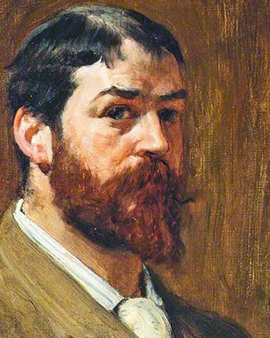Robert Walker Macbeth was a successful Scottish painter and etcher. He came from a family of artists. His father was the portraitist Norman Macbeth, two of his five brothers, James Macbeth and Henry Macbeth-Raeburn also became painters. Ann Macbeth his niece also became an artist and designer. Macbeth began his education in his home city of Edinburgh. Probably he learned the basics from his father. At the age of about 22 years he finally went to London to continue his studies. In London he created paintings for The Graphic Magazine. Macbeth preferred to paint rustic genre pictures and landscapes. Macbeth soon found his way to London and was able to exhibit his paintings successfully in many places. Only one year after his arrival in London he already exhibited at the Royal Academy and the Royal Society of Portrait Painters, among others. In the same year, at the age of 23, Macbeth was accepted as a member of the Royal Watercolor Society. Later he was also accepted as a full member of the Royal Academy, Royal Institute of Painters in Water Colors and the Royal Institute of Oil Painters. This illustrates how versatile Macbeth was in his work as an artist.
Robert Walker Macbeth spent most of his life in London, where he also received part of his education. Nevertheless, the typical characteristics of the Scottish school could be seen in many of his paintings. He therefore not only exhibited in London, but was also very successful with his paintings at the Scottish academies and art societies in Glasgow and Edinburgh. He was also allowed to exhibit his paintings in other regions of the country such as Birmingham, Manchester or Liverpool in renowned galleries and the regional Royal Academies. Macbeth was inspired by the works of George Heming Mason and Frederik Walker. He was also a friend, neighbour and colleague of the painter George Percy Jacomb-Hood.
Besides painting, Macbeth was also interested in etchings and copperplate engravings. At that time these techniques were hardly recognized as art forms in their own right. For this reason he founded the Society of Painters, Etchers and Engravers together with the artists Francis Seymour Haden, Heywood Hardy, Hubert von Herkomer, Alphonse Legros and James Tissot. Their work was of great importance for the recognition of etching and engraving as a respected art form. The Society was officially awarded the Royal Charter in 1888. At the age of 39 Macbeth married Lydia Esther Bates. They had a daughter, Phillis Macbeth, who, like his wife, posed for him in some of his paintings. Phillis later became a celebrated actress under the name Lydia Bilbrook. It is assumed, however, that she was in reality not the biological daughter of Robert Walker Macbeth, but that of the actor Herbert Beerbohm Tree. Macbeth died at the age of 62 in London.
×





.jpg)
.jpg)
.jpg)
.jpg)
.jpg)
.jpg)
.jpg)
.jpg)
.jpg)
.jpg)
.jpg)
.jpg)
.jpg)
.jpg)
.jpg)
.jpg)
.jpg)
.jpg)
.jpg)
.jpg)
.jpg)
.jpg)
.jpg)
.jpg)
.jpg)
.jpg)
.jpg)
.jpg)
.jpg)
.jpg)
_-_(MeisterDrucke-905164).jpg)
_-_(MeisterDrucke-905164).jpg)
.jpg)
.jpg)
.jpg)
.jpg)
.jpg)
.jpg)
.jpg)
.jpg)
.jpg)
.jpg)
.jpg)
.jpg)
.jpg)
.jpg)
.jpg)
.jpg)
.jpg)
.jpg)
_-_(MeisterDrucke-905190).jpg)
_-_(MeisterDrucke-905190).jpg)
.jpg)
.jpg)
.jpg)
.jpg)
_-_(MeisterDrucke-1129011).jpg)
_-_(MeisterDrucke-1129011).jpg)
.jpg)
.jpg)
.jpg)
.jpg)
.jpg)
.jpg)
.jpg)
.jpg)
_-_(MeisterDrucke-1210089).jpg)
_-_(MeisterDrucke-1210089).jpg)
.jpg)
.jpg)
.jpg)
.jpg)
.jpg)
.jpg)
.jpg)
.jpg)
.jpg)
.jpg)
.jpg)
.jpg)
.jpg)
.jpg)
.jpg)
.jpg)
.jpg)
.jpg)
.jpg)
.jpg)
.jpg)
.jpg)
.jpg)
.jpg)
.jpg)
.jpg)
.jpg)
.jpg)
.jpg)
.jpg)
_-_(MeisterDrucke-135509).jpg)
_-_(MeisterDrucke-135509).jpg)
.jpg)
.jpg)
.jpg)
.jpg)
_-_(MeisterDrucke-905318).jpg)
_-_(MeisterDrucke-905318).jpg)
_-_(MeisterDrucke-905165).jpg)
_-_(MeisterDrucke-905165).jpg)
.jpg)
.jpg)
.jpg)
.jpg)
 - (MeisterDrucke-198436).jpg)
 - (MeisterDrucke-198436).jpg)
.jpg)
.jpg)
.jpg)
.jpg)
.jpg)
.jpg)
.jpg)
.jpg)
.jpg)
.jpg)
.jpg)
.jpg)
.jpg)
.jpg)
.jpg)
.jpg)
_-_(MeisterDrucke-1009013).jpg)
_-_(MeisterDrucke-1009013).jpg)
_-_(MeisterDrucke-897158).jpg)
_-_(MeisterDrucke-897158).jpg)
.jpg)
.jpg)
_-_(MeisterDrucke-897154).jpg)
_-_(MeisterDrucke-897154).jpg)
.jpg)
.jpg)
.jpg)
.jpg)
.jpg)
.jpg)
.jpg)
.jpg)
_-_(MeisterDrucke-905191).jpg)
_-_(MeisterDrucke-905191).jpg)
.jpg)
.jpg)
.jpg)
.jpg)
.jpg)
.jpg)
.jpg)
.jpg)
.jpg)
.jpg)
.jpg)
.jpg)
.jpg)
.jpg)
.jpg)
.jpg)
.jpg)
.jpg)
.jpg)
.jpg)






